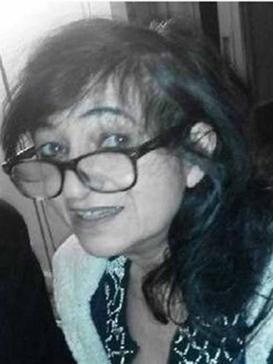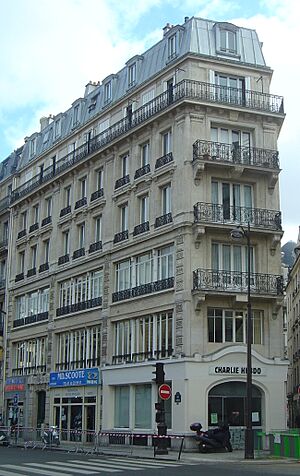Elsa Cayat facts for kids
Quick facts for kids
Elsa Cayat
|
|
|---|---|
 |
|
| Born | 9 March 1960 Sfax, Tunisia
|
| Died | 7 January 2015 (aged 54) Paris, France
|
| Cause of death | Homicide by shooting |
| Resting place | Jewish section of Montparnasse cemetery |
| Nationality | French |
| Occupation | Psychiatrist and psychoanalyst, as well as columnist |
| Years active | 1988–2015 |
| Employer | Charlie Hebdo |
| Known for | Her books and columns in Charlie Hebdo related to psychology |
|
Notable work
|
A Man + A Woman = What? Desire and the ...: The Hidden Stakes of Male ... |
| Partner(s) | Paulus Bolten |
| Children | Hortense (daughter) |
| Relatives | A sister Beatrice, a brother Frederick, and cousins Sophia Bramley and Jacqueline Raoul-Duval |
Elsa Jeanne Cayat (born March 9, 1960 – died January 7, 2015) was a French doctor who helped people with their minds, called a psychiatrist and psychoanalyst. She also wrote articles for a funny newspaper called Charlie Hebdo in Paris, France. Sadly, Elsa was one of 12 people who died in a terrible attack on the Charlie Hebdo office. She was the only woman from the newspaper who was killed that day.
Contents
About Elsa Cayat
Elsa Cayat was born on March 9, 1960, in Sfax, Tunisia. Her father, Georges Khayat, was a doctor from Tunisia. Her mother worked in law. When Elsa was a very young child, her family moved to Paris, France.
Elsa Cayat had a partner named Paulus Bolten, who designed shoes. They had one daughter together, named Hortense.
Elsa was 54 years old when she died in Paris, France, on January 7, 2015. She was buried in the Jewish part of the Montparnasse Cemetery.
Elsa's Career
Elsa Cayat was a psychiatrist and psychoanalyst. This means she was a doctor who helped people understand their feelings and thoughts. She also wrote columns for a newspaper.
She became a qualified doctor when she was 21 years old. Later, she worked as a psychiatrist and psychoanalyst in Paris. She wrote books about psychology, which is the study of the mind. Her first book, A Man + A Woman = What?, came out in 1998. Elsa also helped write parts of other books like Mastering Life.
Elsa wrote a column called Charlie Divan (which means Charlie on the Couch) for the satirical magazine Charlie Hebdo. She believed her column could help people understand their personal lives and emotional problems.
The Attack on Charlie Hebdo
About a month before the attack, Elsa Cayat received threats over the phone. These threats were linked to her religion and her work at Charlie Hebdo. But she kept writing her column, saying the threats were just "verbal garbage." One of her patients said that Elsa "feared nothing."
Charlie Hebdo was a satirical magazine known for printing cartoons about the Prophet Mohammed. Because of this, it had become a target for some extremist groups. On January 7, 2015, two brothers, Saïd and Chérif Kouachi, attacked the Charlie Hebdo offices.
The attackers came into a meeting where Elsa Cayat and others were present. They used automatic rifles and killed twelve people, including Elsa. After the attack, they shouted that they had "avenged the Prophet Mohammed."
Why Charlie Hebdo Was Targeted
Charlie Hebdo was a magazine that used humor and satire to comment on society. It had been threatened many times before. The office had even been firebombed in the past.
The magazine continued to publish cartoons, even when they were controversial. They believed strongly in freedom of speech. The attackers specifically targeted certain cartoonists and staff members during the shooting.
Impact of the Attack
Among the twelve people who died at the Charlie Hebdo office, Elsa Cayat was the only woman on staff who was killed.
Elsa's family believed she was killed because she was Jewish, based on the phone threats she had received earlier. A few weeks before the attack, anonymous callers told her to quit her job, saying she would be killed because she was Jewish. The callers said, "You should stop working for Charlie Hebdo, otherwise we're going to kill you." Her family said she didn't take these threats seriously. The attackers had a chance to kill another female employee, but they spared her, saying, "We don't kill women."
Public Reactions
After the attacks, the phrase "Je Suis Charlie" (which means "I am Charlie") became a popular saying. It was used by people who believed in a free press and supported the victims of the Charlie Hebdo attack.
Many funds were set up to help those affected by the attacks. Fundraisers also helped the families of the victims and paid for the funerals of the Jewish cartoonists who were killed. Within 24 hours of the shooting, French newspapers raised a lot of money. This helped Charlie Hebdo print over 1,000,000 copies of its next issue, much more than their usual 60,000 copies.
Elsa's Writings
- 1998: Un Homme + Une Femme = Quoi? (A Man + A Woman = What?), Paris, Jacques Grancher ISBN: 9782228901857
- 2015: La Capacité de s'aimer (The Capacity to Love Each Other), Paris, Payot ISBN: 2228913332
Awards and Recognition
In 2015, Elsa Cayat was given the Legion of Honour award. This is a very high award in France.
See also
 In Spanish: Elsa Cayat para niños
In Spanish: Elsa Cayat para niños
- Charlie Hebdo shooting
- Maghrebian community of Paris
- List of journalists killed in Europe


